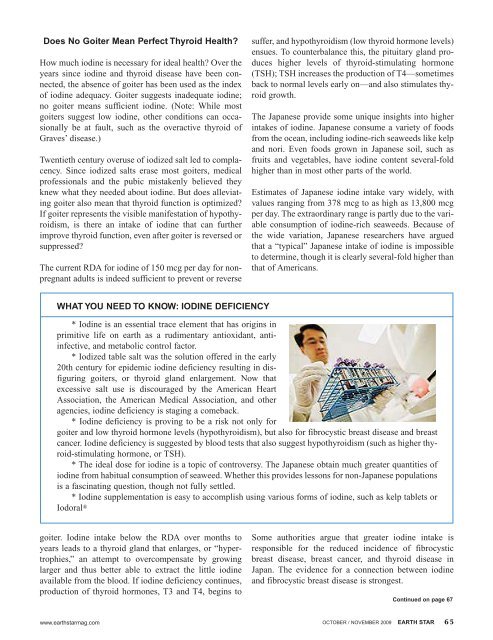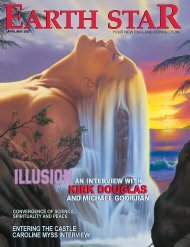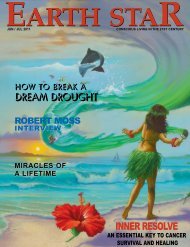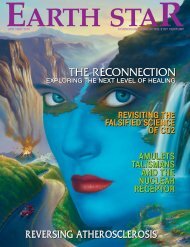WILD ATTRACTION WILD ATTRACTION - Earthstar
WILD ATTRACTION WILD ATTRACTION - Earthstar
WILD ATTRACTION WILD ATTRACTION - Earthstar
- No tags were found...
You also want an ePaper? Increase the reach of your titles
YUMPU automatically turns print PDFs into web optimized ePapers that Google loves.
Does No Goiter Mean Perfect Thyroid Health?How much iodine is necessary for ideal health? Over theyears since iodine and thyroid disease have been connected,the absence of goiter has been used as the indexof iodine adequacy. Goiter suggests inadequate iodine;no goiter means sufficient iodine. (Note: While mostgoiters suggest low iodine, other conditions can occasionallybe at fault, such as the overactive thyroid ofGraves’ disease.)Twentieth century overuse of iodized salt led to complacency.Since iodized salts erase most goiters, medicalprofessionals and the pubic mistakenly believed theyknew what they needed about iodine. But does alleviatinggoiter also mean that thyroid function is optimized?If goiter represents the visible manifestation of hypothyroidism,is there an intake of iodine that can furtherimprove thyroid function, even after goiter is reversed orsuppressed?The current RDA for iodine of 150 mcg per day for nonpregnantadults is indeed sufficient to prevent or reversesuffer, and hypothyroidism (low thyroid hormone levels)ensues. To counterbalance this, the pituitary gland produceshigher levels of thyroid-stimulating hormone(TSH); TSH increases the production of T4—sometimesback to normal levels early on—and also stimulates thyroidgrowth.The Japanese provide some unique insights into higherintakes of iodine. Japanese consume a variety of foodsfrom the ocean, including iodine-rich seaweeds like kelpand nori. Even foods grown in Japanese soil, such asfruits and vegetables, have iodine content several-foldhigher than in most other parts of the world.Estimates of Japanese iodine intake vary widely, withvalues ranging from 378 mcg to as high as 13,800 mcgper day. The extraordinary range is partly due to the variableconsumption of iodine-rich seaweeds. Because ofthe wide variation, Japanese researchers have arguedthat a “typical” Japanese intake of iodine is impossibleto determine, though it is clearly several-fold higher thanthat of Americans.WHAT YOU NEED TO KNOW: IODINE DEFICIENCY* Iodine is an essential trace element that has origins inprimitive life on earth as a rudimentary antioxidant, antiinfective,and metabolic control factor.* Iodized table salt was the solution offered in the early20th century for epidemic iodine deficiency resulting in disfiguringgoiters, or thyroid gland enlargement. Now thatexcessive salt use is discouraged by the American HeartAssociation, the American Medical Association, and otheragencies, iodine deficiency is staging a comeback.* Iodine deficiency is proving to be a risk not only forgoiter and low thyroid hormone levels (hypothyroidism), but also for fibrocystic breast disease and breastcancer. Iodine deficiency is suggested by blood tests that also suggest hypothyroidism (such as higher thyroid-stimulatinghormone, or TSH).* The ideal dose for iodine is a topic of controversy. The Japanese obtain much greater quantities ofiodine from habitual consumption of seaweed. Whether this provides lessons for non-Japanese populationsis a fascinating question, though not fully settled.* Iodine supplementation is easy to accomplish using various forms of iodine, such as kelp tablets orIodoral ®goiter. Iodine intake below the RDA over months toyears leads to a thyroid gland that enlarges, or “hypertrophies,”an attempt to overcompensate by growinglarger and thus better able to extract the little iodineavailable from the blood. If iodine deficiency continues,production of thyroid hormones, T3 and T4, begins toSome authorities argue that greater iodine intake isresponsible for the reduced incidence of fibrocysticbreast disease, breast cancer, and thyroid disease inJapan. The evidence for a connection between iodineand fibrocystic breast disease is strongest.Continued on page 67www.earthstarmag.comOCTOBER / NOVEMBER 2009 EARTH STAR 65
















